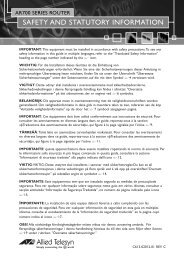Chapter 3: Using the Graphical User Interface (GUI) - Allied Telesis
Chapter 3: Using the Graphical User Interface (GUI) - Allied Telesis
Chapter 3: Using the Graphical User Interface (GUI) - Allied Telesis
Create successful ePaper yourself
Turn your PDF publications into a flip-book with our unique Google optimized e-Paper software.
3-8 <strong>Allied</strong>Ware OS Software Reference<br />
5. Assign <strong>the</strong> vlan1 interface an IP address.<br />
add ip interface=vlan1 ip=ipaddress mask=mask<br />
If you use DHCP to assign IP addresses to devices on your LAN, and you<br />
want to manage <strong>the</strong> switch within this DHCP regime, we recommend that<br />
you set your DHCP server to always assign <strong>the</strong> same IP address to <strong>the</strong><br />
switch. This lets you access <strong>the</strong> <strong>GUI</strong> by browsing to that IP address, and<br />
also lets you use <strong>the</strong> switch as a gateway device for your LAN. If you need<br />
<strong>the</strong> switch's MAC address for this, you can display it with <strong>the</strong> command<br />
show switch. To set <strong>the</strong> interface to obtain its IP address by DHCP, use <strong>the</strong><br />
commands:<br />
add ip interface=vlan1 ipaddress=dhcp<br />
enable ip remoteassign<br />
6. If <strong>the</strong> PC you want to browse from is in a different subnet from <strong>the</strong> switch, give <strong>the</strong><br />
switch a route to <strong>the</strong> PC.<br />
add ip route=pc-subnet interface=vlan1<br />
nexthop=gateway-ipaddress<br />
where:<br />
PC-subnet is <strong>the</strong> IP subnet address of <strong>the</strong> PC. For example, if <strong>the</strong> PC has<br />
an IP address of 192.168.6.1 and a mask of 255.255.255.0, its subnet<br />
address is 192.168.6.0.<br />
gateway-ipaddress is <strong>the</strong> IP address of <strong>the</strong> gateway device that connects<br />
<strong>the</strong> PC’s subnet with <strong>the</strong> switch’s subnet (Figure 3-4 on page 3-7).<br />
7. If you want to be able to browse to <strong>the</strong> <strong>GUI</strong> securely, configure SSL (Secure Sockets<br />
Layer).<br />
For a step-by-step example, see “Configuration Example” on page 34-6 of<br />
<strong>Chapter</strong> 34, Secure Sockets Layer (SSL).<br />
8. Save <strong>the</strong> configuration and set <strong>the</strong> switch to use it on bootup.<br />
create config=filename.cfg<br />
set config=filename.cfg<br />
9. On <strong>the</strong> PC, bypass <strong>the</strong> HTTP proxy server, if necessary.<br />
See “HTTP Proxy Servers” on page 3-4 for more information.<br />
10. Point your web browser at <strong>the</strong> LAN interface’s IP address.<br />
For normal access, point your web browser to<br />
http://ip-address<br />
For secure access, point your web browser to<br />
https://ip-address<br />
where ip-address is <strong>the</strong> interface’s IP address.<br />
For more information about secure access, see “Configuration Example” on<br />
page 34-6 of <strong>Chapter</strong> 34, Secure Sockets Layer (SSL).<br />
11. At <strong>the</strong> login prompt, enter <strong>the</strong> user name and password.<br />
The default username is manager:<br />
<strong>User</strong> Name: manager<br />
Password: friend<br />
The System Status page is displayed (Figure 3-5 on page 3-10). Select<br />
options from <strong>the</strong> sidebar menu to configure and manage <strong>the</strong> switch.<br />
Software Version 2.9.1/3.2.1<br />
C613-03130-00 REV A









